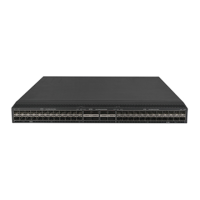6
Configuring the TPID for CVLAN tags
1. Enter system view.
system-view
2. Set the TPID for CVLAN tags.
qinq ethernet-type customer-tag hex-value
By default, the TPID is 0x8100 for CVLAN tags.
Configuring the TPID for SVLAN tags
1. Enter system view.
system-view
2. Enter Layer 2 Ethernet interface view or Layer 2 aggregate interface view.
interface interface-type interface-number
3. Set the TPID for SVLAN tags.
qinq ethernet-type service-tag hex-value
By default, the TPID is 0x8100 for SVLAN tags.
Setting the 802.1p priority in SVLAN tags
About the 802.1p priority in SVLAN tags
By default, the 802.1p priority in the SVLAN tag added by a QinQ-enabled port depends on the
priority trust mode on the port.
• If the 802.1p priority in frames is trusted, the device copies the 802.1p priority in the CVLAN tag
to the SVLAN tag.
• If port priority is trusted, the port priority (0 by default) is used as the 802.1p priority in the
SVLAN tag.
You can configure a QoS policy to modify the 802.1p priority in SVLAN tags as follows:
• Modify the 802.1p priority in the SVLAN tag based on the 802.1p priority in the CVLAN tag or
the CVLAN ID.
• Copy the 802.1p priority in the CVLAN tag to the SVLAN tag.
For more information about QoS policies and priority trust mode, see ACL and QoS Configuration
Guide.
Prerequisites for setting the 802.1p priority in SVLAN tags
1. Enable QinQ. For more information, see "Enabling QinQ."
To use the CVLAN ID or 802.1p priority of the CVLAN tag to set the 802.1p priority of the
SVLAN tag, you must first enable QinQ on the port.
2. Use the
qos trust dot1p command to configure the port to trust the 802.1p priority in
incoming frames. For more information, see ACL and QoS Configuration Guide.
This setting is required if the
remark dot1p command is configured. It is optional if the
remark dot1p customer-dot1p-trust command is configured.

